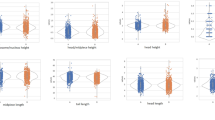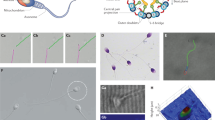Abstract
SEPARATION of sperm bearing X and Y chromosomes is limited by, among other difficulties, the inability to distinguish between the two cell types. The two types of sperm can be distinguished only in man because the Y chromosome is highly fluorescent when stained with quinicrine mustard1. Because of the greater length of the X chromosome than the Y chromosome, it is expected that X-bearing sperm will have a greater DNA content. Based on chromosome length measurements2, the difference in DNA content between X-bearing sperm of the mouse (Mus musculus), which carry 19 autosomes plus the X chromosome, and the Y-bearing sperm, which carry the autosomes plus the Y chromosome, is expected to be 3.4%. Distinguishing X and Y sperm on the basis of this difference requires a method of measurement of DNA content with high precision. We have been able to resolve the two classes of spermatids by pulse cytophotometry (that is, flow microfluorometry).
This is a preview of subscription content, access via your institution
Access options
Subscribe to this journal
Receive 51 print issues and online access
$199.00 per year
only $3.90 per issue
Buy this article
- Purchase on Springer Link
- Instant access to full article PDF
Prices may be subject to local taxes which are calculated during checkout
Similar content being viewed by others
References
Sumner, A. T., Robinson, J. A. & Evans, A. J. Nature new Biol. 229, 231–233 (1971).
Hsu, T. C. & Benirschke, K. An Atlas of Mammalian Chromosomes 5, folio 17 (Springer, New York, 1967).
Gledhill, B. L. et al. J. cell. Physiol. 87, 367–376 (1976).
Van Dilla, M. A. et al. J. Histochem. Cytochem. 25, 763–777 (1977).
Göhde, W., Schumann, J., Büchner, Th., Otto, F. & Barlogie, B. in Flow Cytometry and Sorting (eds Melamed, M. R., Mullaney, P. F. & Mendelsohn, M. L.) (Wiley, New York, in the press).
Zante, J., Schumann, J., Barlogie, B., Göhde, W. & Büchner, Th. in Pulse Cytophotometry II (eds Göhde, W. et al.) 97–106 (European Press, Gent, 1976).
Barlogie, B. et al. Blood 48, 245–258 (1976).
Oakberg, E. F. Am. J. Anat. 99, 391–414 (1956).
Grimes, S. R., Platz, R. D., Meistrich, M. L. & Hnilica, L. S. Biochem. biophys. Res. Commun. 57, 182–189 (1975).
Meistrich, M. L., Lake, S., Steinmetz, L. L. & Gledhill, B. L. Mutat. Res. 49, 383–396 (1978).
Meistrich, M. L. in Methods in Cell Biology 13 (ed. Prescott, D. M.) (Academic, New York, 1977).
Grabske, R. J., Lake, S., Gledhill, B. L. & Meistrich, M. L. J. cell. Physiol. 86, 177–190 (1975).
Meistrich, M. L., Lake, S., Steinmetz, L. L. & Gledhill, B. L. Mutat. Res. 49, 397–405 (1978).
Zante, J., Schumann, J., Göhde, W. & Hacker, U. Histochemistry 54, 1–7 (1977).
Gledhill, B. L., Gledhill, M. P., Rigler, R. & Ringertz, N. R. Expl Cell Res. 41, 652–665 (1966).
Author information
Authors and Affiliations
Rights and permissions
About this article
Cite this article
MEISTRICH, M., GÖHDE, W., WHITE, R. et al. Resolution of X and Y spermatids by pulse cytophotometry. Nature 274, 821–823 (1978). https://doi.org/10.1038/274821a0
Received:
Accepted:
Issue Date:
DOI: https://doi.org/10.1038/274821a0
This article is cited by
-
Factors influencing the electrokinetic dispersion of PAH-degrading bacteria in a laboratory model aquifer
Applied Microbiology and Biotechnology (2008)
-
Spontaneous meiotic non-disjunction in mammals. A study evaluating the various experimental approaches
Genetica (1981)
-
?Cytogenetic? studies of spermatids of mice carrying Cattanach's translocation by flow cytometry
Chromosoma (1979)
-
Flow cytometry of human spermatozoa
Histochemistry (1979)
Comments
By submitting a comment you agree to abide by our Terms and Community Guidelines. If you find something abusive or that does not comply with our terms or guidelines please flag it as inappropriate.



